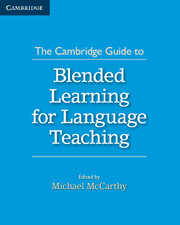Chapter 12 - A Case Study in Blended Learning Course Design
Published online by Cambridge University Press: 22 September 2021
Summary
INTRODUCTION
This chapter will describe the process of creating a blended English language teaching product based on a successful published course series. It will discuss the challenges of designing a product whose use was intended to be entirely flexible between print and online and how these challenges were met. In addition, it will outline the benefits and limitations posed by the online learning environment for highly interactive materials that emphasise inductive learning (where learners notice language patterns and start to formulate rules about them) and the teaching of conversation management skills. At the heart of creating the product was the need to address one of the most significant differences between the print and online media. The print material assumes the role of a teacher as the interpreter of the content, using methods of instruction learned from their professional training and experience which are prompted by the content or suggested in the accompanying Teacher’s Book. In the online world, on the other hand, the material needs to provide content, method and teacher roles; the computer is both tutor and tool (Levy, 1997). This chapter will describe the principles behind the design of the material, with particular reference to teaching grammar and conversation management strategies, and set out solutions that were chosen to meet the many challenges. Finally, some preliminary results from studies after the adoption of this particular blended learning (BL) programme by a number of institutions are briefly reported on.
BACKGROUND TO THE BLENDED LEARNING PRODUCT
The motivation to create a blended product was a joint partnership between the Laureate International Universities network (http://www.laureate.net/) and the publisher of this book, Cambridge University Press, as part of a larger, much more ambitious programme on the part of Laureate to redefine and restructure the Laureate English Programme (LEP). The need for a blended approach to their English language programmes became apparent largely because of the difficulty for universities in the network to provide sufficient faceto- face classroom instruction to enable students to reach a B1 (CEFR) level of language proficiency, which was a clearly defined objective of the LEP.
- Type
- Chapter
- Information
- The Cambridge Guide to Blended Learning for Language Teaching , pp. 200 - 216Publisher: Cambridge University PressPrint publication year: 2015

